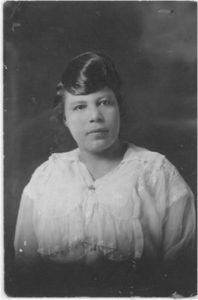
Lillian Jones Horace
*Lillian Bertha Jones Horace was born on this date in 1880. She was a Black author, educator, and librarian.
Lillian Bertha Amstead was born in Jefferson, Texas, to Thomas Amstead and Macey Ackard Matthews; she also had one sister, Etta. The family moved to Fort Worth when Lillian was two years old. Thomas failed to support them financially, so the girls grew up helping their mother make ends meet. A self-described "dreamy" and "mystical" child, she attended the East Ninth Street Colored School (renamed I.M. Terrell High School in 1921) in Fort Worth and Mt. Gilead Baptist Church.
In 1898-99, Amstead attended Bishop College in Marshall, Texas, attaining her commitment to the Baptist faith. She participated at the Dallas Summer Normal Institute, a segregated teacher education program, in 1905. In 1914, she enrolled at Prairie View State Normal and Industrial College (now Prairie View A&M University) and graduated valedictorian in a class of seventy-four. Returning to Fort Worth to teach during the school year, Lillian attended summer courses at the University of Chicago in 1917, 1918, 1919, 1928, and 1940; at the University of Colorado Boulder in 1920; and at Columbia University in 1924. From 1920–1921, she attended Simmons College in Louisville, Kentucky, where she earned her bachelor's degree in 1922.
While at Simmons College, she held the position of Dean of Women. Jones would return to the University of Chicago in 1940 to study for a master's degree in Library Science. After moving back to the South, she married David Jones. For the first few years of their marriage, they lived with his family in Denton, Texas. She passed her teaching exams and first taught in 1901 at a rural Parvin in Denton County school. The following year, she became principal of the Handley Colored School, a one-room school in the Handley community east of Fort Worth. In 1911, she returned to I.M. Terrell High School to teach English.
During her teaching career at I.M. Terrell, she established the school's journalism and drama departments and started a School Newspaper. Jones formed the school's first library, and for many years, she served as the school's dean of girls.
Though teaching was her career, she wanted "to write a book worth reading by an intelligent person, not necessarily a friend." In 1916, Jones self-published her first book of romantic fiction, Five Generations Hence, the first known novel by a Black woman in Texas. The plot of the migration narrative, centering on fictional Black educator Grace Noble, presents Black women as heroines and the return of Blacks to Africa as a "plausible solution to the obstacles facing blacks in the South," five generations after their enslavement and transport to the Americas.
The book was not widely distributed but came to scholars' attention in 1995 in Daring to Dream: Utopian Stories by United States Women, 1836-1919. In 1938, she began writing a biography of Dr. Lacey Kirk Williams, the minister of Chicago's Olivet Baptist Church. He had been a minister at Jones' own Mt. Gilead Baptist Church in Fort Worth. Williams died in a plane crash in 1940. Although Lillian finished the book the following year, power struggles within the National Baptist Convention prevented the distribution of the book until 1964, when it gained the attention of Martin Luther King Jr. "Crowned with Glory and Honor": The Life of Rev. Lacey Kirk Williams was published in posthumously in 1978.
Jone's second novel, Angie Brown, was written while traveling between Texas and California after her divorce from her second husband. Angie Brown focuses on the women's shared experience and envisions "cooperation between black and white women ."Angie Brown: A Jim Crow Romance was published posthumously in 2017. Lillian B. Horace was a member of the Texas Commission on Interracial Cooperation, Zeta Phi Beta sorority, and Alphin Art & Charity Club. She part of the Progressive Women's Club, Women's Council of Mt. Gilead, Heroines of Jericho, and Order of the Eastern Star; she also served as chaplain of the National Association of Colored Women's Clubs. She was also involved with the Texas Library Association and the National PTA. As a local civic leader, she significantly influenced local African American women like educator Hazel Harvey Peace and civil rights activist Lulu B. White.
Both of Lillian's marriages ended in divorce, strained by her professional and personal ambitions. Lillian married David Jones, the son of her pastor at Mt. Gilead Baptist Church, in 1900; the couple divorced in 1919. She married Joseph Gentry Horace in 1930. With her support, he enrolled in Bishop College seminary in 1935. The couple relocated to the Chicago area when he transferred to Northern Seminary five years later, earning his bachelor's degree in 1942 and master's degree in theology in 1943. J. Gentry became a minister at the Second Baptist Church of Evanston, Illinois.
After his mistress's husband exposed J. Gentry's longstanding affair with a local woman, Portia Cooke, he moved to another church. Lillian returned to Fort Worth after some time spent traveling west of the country. Their divorce was in 1946. She had no children with Jones or Horace. She died of heart disease on August 6, 1965.
She was buried at Old Trinity Cemetery, Fort Worth's historic Oakwood Cemetery African American section. Lillian Bertha Jones Horace's literary works were lost for many decades until Karen Kossie-Chernyshev, a professor at Texas Southern University, located her diary and novels at Fort Worth Public Library. She was one of the only Black women writers working in the South during the 1940s.